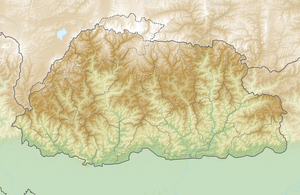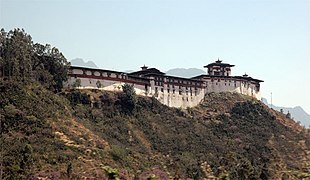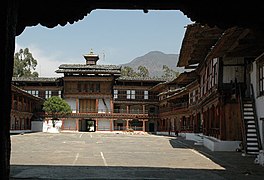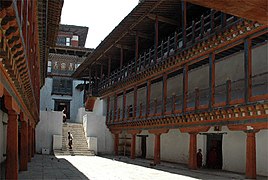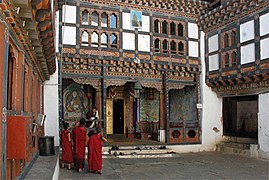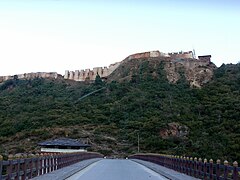Wangdue Phodrang Dzong
| Wangdue Phodrang Dzong | ||
|---|---|---|
| Creation time : | 1638/39 | |
| Castle type : | Dzong (monastery castle) | |
| Geographical location | 27 ° 28 '30 " N , 89 ° 53' 50" E | |
|
|
||
The Wangdue-Phodrang-Dzong is the dzong of the Wangdue Phodrang district in central Bhutan . The Dzong is the third oldest monastery castle after the Semtokha Dzong and Punakha Dzong , the foundation of which goes back to Shabdrung Ngawang Namgyel . The Wangdue Phodrang Dzong-forms together with Punakha-, periodontal , Trongsa- and Dagana-Dzong to a group of five Dzong, which in the 2012 Tentative List for World Heritage in Bhutan were taken. This list contains the objects that the government of Bhutan intends to propose to the World Heritage Committee for inclusion in UNESCO World Heritage .
location
The dzong lies on a narrow ridge in a dominant position over the confluence of the Puna Tsang Chhu and Dang Chhu rivers . Below the dzong, a bridge leads the road from Thimphu via Punakha over the Puna Tsang Chhu. The road runs at the foot of the ridge upstream along the Puna Tsang Chhu to Wangdue Phodrang , the capital of the district of the same name and from there further to the distant, eastern districts of Bhutan.
history
Shabdrung Ngawang Namgyel founded the Wangdue-Phodrang-Dzong in 1638. Construction work was completed just a year later. The local Drukpa monk community, to which up to 250 monks belonged in later years, traces its origin to the founding of Ngawang Namgyel. A few decades later, around 1683, the original dzong was expanded by Tenzin Rabgye , who later became the fourth Druk Desi (secular ruler of Bhutan). He added a second two-story Utse to the four-story main tower ( Utse ) that the Shabdrung had built . Later again, the dzong was extended to the north in the direction of today's city of Wangdue Phodrang, and was expanded and rebuilt by local rulers ( dzongpons ). In the course of its history, the dzong was destroyed several times by earthquakes, in 1897 and 2011, and by conflagrations , in 1837 and most recently in 2012.
On Sunday, June 24, 2012, a violent fire broke out for an unexplained cause - an electrical short circuit or open flames of the candlesticks in one of the temples caused by wind - a violent fire. Although the rushing helpers managed to recover most of the irreplaceable Buddhist works of art, the dzong burned down completely. Despite the proximity of the two rivers at the foot of the ridge, the altitude of the buildings made the extinguishing work much more difficult, so that even on Monday evening some nests of fire were not completely extinguished.
Bhutan's Prime Minister Jigmi Thinley immediately announced that the dzong would be rebuilt. The Swiss engineering firm WaltGalmarini AG was also involved in the planning of the reconstruction. They combined traditional Bhutanese architecture with modern methods in the construction of the new Punakha Bridge, 15 km to the north . For the reconstruction of the dzong, concepts should be developed how the traditional construction technology could be modernized in order to significantly increase the resistance of traditionally built buildings to earthquakes. For example, insulation mats and slide bearings are used to isolate the main tower ( Utse ) from vibrations .
First, the fire ruins were removed down to the courtyard level, the actual reconstruction began in September 2014. By spring 2016, the three-story assembly hall of the monks ( kunre ) at the south end of the dzong was completed. The new building was inaugurated in April 2016 with a solemn ceremony lasting several days in memory of Shabdrung Ngawang Namgyel's arrival in Bhutan 400 years ago. At times, up to 400 workers are employed on the construction site of the dzong. The reconstruction is expected to be completed in 2021. The dzong will then house 15 shrines, as well as accommodation for around 100 monks and office space for more than 30 departments of the Wangdue Phodrang County Administration.
Architecture and equipment
The Dzong, which was destroyed in 2012, was a building complex stretching along the ridge with three courtyards, one after the other from north to south. The clapboard-roofed buildings were built following the traditional construction method, made of whitewashed, clay-bound quarry stone masonry with wooden beam galleries in front. The northern main gate led to the first, elongated inner courtyard surrounded by administration buildings. The second part of the dzong was separated from the first by a small gorge, over which a short bridge led to a second gate. This was followed by the second, narrow inner courtyard, which ended in a flight of stairs that climbed to the central tower. A third passage led into a third inner courtyard, on the south side of which was the assembly hall of the monks. This was decorated with statues of the past, present and future Buddha .
Founding legends
Legend has it that Shabdrung Ngawang Namgyel was staying at Chime-Lhakhang in Punakha when he met a decrepit man. The man told of a ridge in the area of what is now Wangdue Phodrang District, which is shaped like a "sleeping elephant", and prophesied to the Shabdrung that he would unite the country by building a monastery castle on the ridge of this ridge. Believing that the old man Yeshe Gompo (= Mahakala, a protective deity of Bhutan), the Shabdrung followed the suggestion and sent a nobleman to explore the area. As the envoy approached the area described, he saw four ravens circling over the ridge. When he got there, the birds flew away in the four cardinal directions, north, south, east and west. When he returned to Chime-Lhakhang, he reported about it. Shabdrung Ngawang Namgyel interpreted this incident as a good omen and immediately set about building a dzong. A variant of this tradition closes with an interpretation of the name: In 1638 the Shabdrung came to the place described and built a fortress there, which he called Wangdue Phodrang, which means something like "Palace in which the four cardinal points through the power (of the Shabdrung) getting together".
Another popular tale offers a different interpretation of the name: When the Shabdrung came to the river, he happened to meet a little boy there who was building a fortress out of sand. The Shabdrung asked for the name of the boy, who was called Wangdue, and so the Shabdrung decided to name the Dzong Wangdue Phodrang, which means "Palace of Wangdue".
Picture gallery
literature
- Françoise Pommaret: Bhutan . Edition Earth • Travel Guide. 11th edition. Edition Temmen, Bremen 2013, ISBN 978-3-86108-810-3 , pp. 161 .
Web links
- Wangdue Phodrang Dzong. DIT - Department of Information Technology & Telecom, Ministry of Information and Communication, Government of Bhutan, archived from the original on June 4, 2013 ; accessed on November 25, 2017 (English).
Individual evidence
- ^ Dzongs: the center of temporal and religious authorities. Entry in the tentative list of Bhutan. World Heritage Center, March 8, 2012, accessed November 21, 2017 .
- ↑ Kuenray of Wangdue dzong to be completed in March. Kuensel Online , January 28, 2016, accessed on November 25, 2017 (English).
- ↑ a b c Wangdue Phodrang Dzong. DIT - Department of Information Technology & Telecom, Ministry of Information and Communication, archived from the original on June 4, 2013 ; accessed on March 17, 2017 (English).
- ↑ Wangduephodrang Dzong. RAOnline, Switzerland, accessed November 25, 2017 (English).
- ↑ a b Bhutan's Wangdue Phodrang temple to be rebuilt after fire. BBC News , June 26, 2012, accessed November 21, 2017 .
- ↑ Reconstruction of a dzong in Bhutan. WaltGalmarini AG, accessed on November 25, 2017 .
- ↑ Tower building in the Himalayas: solid Swiss. Pp. 22–25 , accessed on November 25, 2017 (published in Angst + Pfister Magazin International 14/2007, PDF download (DE) ).
- ↑ Kuenray of Wangdue dzong completed. Kuensel Online , April 16, 2016, accessed on November 25, 2017 (English).
- ↑ Kuenrey of Wangdue Dzong consecrated. Kuensel Online , April 21, 2016, accessed on November 25, 2017 (English).
- ↑ Wangduephodrang dzong rises to glory stronger. Kuensel Online , September 18, 2017, accessed on November 25, 2017 (English).
- ↑ Five dzongs nominated for World Heritage list. Kuensel Online , January 26, 2015, accessed on November 21, 2017 (English).
- ↑ a b c Françoise Pommaret: Bhutan . Edition Earth • Travel Guide. 11th edition. Edition Temmen, Bremen 2013, ISBN 978-3-86108-810-3 , pp. 161 .

